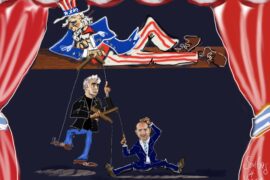In the wake of the Knesset approving the first section of their ambitious judicial reform legislation, removing the “reasonability clause” which has until now allowed the Supreme Court to invalidate legislation deemed “unreasonable” by the judges without any legal basis, the political atmosphere is shifting.
As anti-government protests continue, voices within the Knesset and interested parties in the United States are singing a new tune.
In the last week, various members of Prime Minister Binyamin Netanyahu’s Likud party, the largest faction in the Knesset, have publicly expressed their insistence that further legislation towards judicial reform be agreed upon by the opposition as well – and even threatened to oppose legislation that doesn’t receive broad acceptance.
While such calls may be politically expedient on a personal level, ingratiating these lawmakers with moderate Likud voters, and with the Israeli media, it’s a disaster for both party and coalition discipline.
Ensuring the opposition that the government doesn’t have a majority won’t guarantee an agreed-upon middle ground. It will only harden the resolve of the opposition to neuter the most meaningful sections of the proposed reform.
But this crack in the cohesion of the Likud party is nothing new.
In 2005, as US President George W. Bush forced Israeli Prime Minister Ariel Sharon to forcibly expel all Jews from the Gaza region and demolish all Jewish communities there, a referendum within Sharon’s own Likud party showed that the majority of party members were against the policy.
Ignoring the results of the referendum, Sharon was able to pass a vote within his cabinet – but only after creating an artificial majority by dismissing cabinet members from the National Union faction and replacing them with Likud lawmakers loyal to him.
Sharon faced further opposition from the National Religious Party (who ended up leaving the coalition) and members of his own faction (including Netanyahu) who called for a national referendum before advancing the expulsion.
Rather than turning to the nation, Sharon formed a unity government with Shimon Peres’s Labor party in order to ensure a Knesset majority. While the new government moved forward, Netanyahu eventually resigned his position as finance minister in protest of the move.
In the wake of the expulsion, Sharon, Ehud Olmert, Tzipi Livni, and other Likud lawmakers broke away to form the Kadima party together with Peres and other Labor faction parliamentarians. As Netanyahu took over the Likud party leadership, Kadima saw short-term electoral success, winning more seats than any other faction and forming a government with Labor, Shas, and the Pensioners Party. By the 2009 elections, however, Netanyahu had emerged victorious and remained prime minister for twelve years as Kadima gradually floundered in the opposition.
Again in 2015, after leaving the Likud over his support for the 2011 protests (allegedly engineered by Democratic Party strategist Stanley Greenberg who played a leading role on the American team that removed Netanyahu from office in 1999), Moshe Kaḥlon created Kulanu, a faction of Likud breakaways and refugees from the political collapse of Kadima. Lawmakers on Kaḥlon’s list included current Defense Minister Yoav Galant, current Foreign Minister Eli Cohen, and current New Hope lawmaker Yifat Shasha-Biton. But after flopping in the April 2019 elections, the party rejoined the Likud for the September 2019 elections.
By this time, however, former Netanyahu ally Avigdor Lieberman (Yisrael Beiteinu) – possibly in coordination with Washington – had destabilized the government and forced a series of inconclusive elections. Lieberman struggled unsuccessfully during this time to create a unity government that would accept President Donald Trump’s two-state plan.
Similarly, former Likud minister Moshe Yaalon formed the Telem faction in early 2019, ultimately merging with Benny Gantz’s Blue & White alliance before the April elections.
After Telem ultimately split from Gantz for the 2020 elections, Netanyahu formed a short-lived unity government with Blue & White – excluding both Lieberman and Yaalon. Repeating history, disgruntled Likud lawmakers split from the party to form New Hope ahead of the 2021 elections, with Gideon S’ar, Yifat Shasha-Biton (again), Z’ev Elkin (who had defected to Likud from Kadima a decade earlier), Benny Begin, and others from the Likud joining Telem refugees Zvi Hauser and Yoaz Hendel.
This constellation of former Likud lawmakers and former Netanyahu allies were able to briefly join the anti-Netanyahu plutocracy government following the 2021 elections, before its collapse under the leadership of Naftali Bennet (Yamina) and Yair Lapid (Yesh Atid).
In 2022, Netanyahu was able to recover from his loss to manage another significant electoral victory. His government, dubbed “the farthest right government in Israeli history” is no coincidence – over 15 years of centrist departures from the party, growing antagonism from Netanyahu’s westernized conservative allies over the meaning of a Jewish state, assorted corruption charges against him, and repeated concerted efforts by US administrations to replace or neuter him, the people of Israel continue to choose Netanyahu’s Likud.
So before getting excited over the “rebellion” in the governing coalition, we should remind ourselves that this isn’t the first time Netanyahu has faced such challenges – and may not be the last.
Agricultural Minister Avi Dichter, who referred to the lawmakers responsible for advancing the judicial reform as “bullies,” comparing them to the granary-burning rebel Zealots on the eve of the Great Revolt, was a longtime Kadima lawmakers, joining the Likud only after its collapse. The fact that he’s been joined by career Likudniks shouldn’t shock anyone – S’ar, Yaalon, Kaḥlon, and Olmert were also once loyal Likud members.
Defense Minister Yoav Galant, who earlier this year threatened to break coalition discipline by voting against the judicial reform bills in the face of mass protests, left the Likud in 2015 to join Kaḥlon’s Kulanu, jumping ship to rejoin the Likud just before Kulanu’s electoral collapse. But his newest moves may help bring into focus what’s really behind the apparent revolt in the Likud ranks.
Late last week, after the reasonableness clause was canceled by the Knesset, Galant met with US General Michael Kurilla, the commander of USCENTCOM for a regular meeting between Israel’s defense minister and the American general. What was irregular, however, was their conversation. Ynet reported that the two discussed the current political turmoil in Israel, and that Galant assured the general that the voting public behind Netanyahu is politically less nationalist and more friendly to Western interests than their representatives in Knesset, using the metaphor of the Leaning Tower of Pisa – with a stable base and tilted upper levels – to convey his point.
Whether he was sharing this appraisal for the sake of cordial relations or as a plea for imperial support in straightening the tower is unclear at the moment. But in any case, Galant was telling the Americans exactly what they want to hear – that the Israeli public is behind the moderate center, and not the current “extreme right” government.
This coincides precisely with Washington’s most recent attempts to use normalization with Saudi Arabia as a pretext for interfering in Israel’s domestic politics. In his recent opinion piece in the New York Times, Thomas Friedman made it clear that the conditioning of a deal on Palestinian issues is far more central to Washington’s interests than it is to Riyadh’s – the Saudis care less about the Palestinians than they do about American arms, NATO security agreements, and a civilian nuclear program.
Friedman also intimated that Washington may be hoping to use a Saudi peace agreement as a carrot, since their support of anti-government protests in Israel has failed as a stick. If given the choice between normalization with Riyadh and maintaining a policy of Jewish construction in the West Bank, Netanyahu would have to abandon his allies in the Religious Zionism faction in order to cement his legacy as a peacemaker with Arab states.
In such a scenario, Netanyahu would necessarily have to find new coalition partners – likely Benny Gantz’s National Unity faction, allowing him to maintain a 62 seat majority. Galant would clearly have no qualms about giving up the defense ministry to Gantz to ensure the deal. If UTJ and Shas prove uncompromising as well, they can easily be replaced by Yair Lapid’s Yesh Atid, as suggested by billionaire president of the World Jewish Congress, Ronald Lauder. And Washington will have its ideologically bland coalition, which would lack the motivation to resist Western attempts to divide our land or neuter the power of our elitist Supreme Court.
Our sages teach us that our leaders reflect their generation (Arakhin 17a). Israel’s leading party is ideologically split between a Western conservative wing and a Jewish traditional wing, just as the nation is split between factious tribes fighting between liberalism and a more deeply Jewish state. And our prime minister, Binyamin Netanyahu, stands squarely in the middle – struggling endlessly to balance these two polls, and find a path forward that can unite them.
One thing is clear – Netanyahu’s decades of experience handling intra-party coups, factional splits, domestic opposition and foreign pressure have made him the man best suited to navigate through this current moment of national crisis. But only time will tell if he’s truly up for this formidable task.





